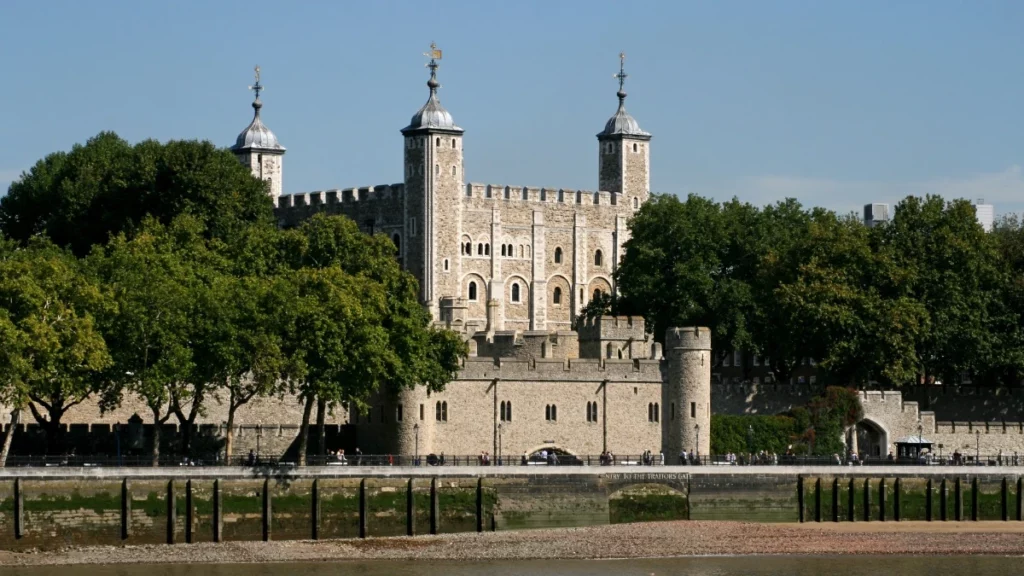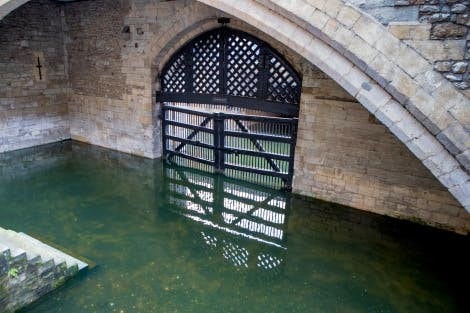
The Tower of London, a historic castle on the north bank of the River Thames in central London, is a must-visit for anyone interested in British history.
If you plan to spend only an hour to 90 minutes at the Tower of London, check out our first three recommendations.
If you have a full three hours on your hand, you must try and explore everything we have listed below.
Jewel House

The Jewel House has a world-famous collection of 23,578 gemstones, some of which are still in use.
The Crown Jewels, which are part of the Royal Collection, are the most potent symbols of the British Monarchy.
From 12 noon to 3 pm, this part of the Tower of London sees long queues.
The Ravens at South Lawn
Charles II believed that if the six Ravens living in the Tower leave, both the Fortress and Britain will be in trouble.
So he ordered them to be kept safe in the Tower.
Today one of their wings is clipped, so they can’t fly away. There is even a backup raven – so there are seven in total.
The ravens are free to roam the Tower of London and respond only to the Ravenmaster.
Plan your visit better – find out everything about Tower of London tickets.
Medieval Palace
Medieval Palace combines three Towers – St Thomas’ Tower, the Wakefield Tower, and the Lanthorn Tower.
It is at the center of the Tower of London’s residential area.
These Towers got built in the 13th century by Henry III and his son Edward I.
At the Medieval Palace, visitors can see how 13th-century life used to be in the London Tower.
Tour with Yeoman Warders Group

Go on the 30-minute tour with the Yeoman Warders group for a quick tour of the Fortress. Meet them at the entrance.
Also known as Beefeaters, they narrate stories from the thousand-year history of the Fortress.
Note: Parts of the Yeoman Warder tour may be scary to young children.
The Execution site
This area is a green space stretching to the west of the White Tower.
It is difficult to imagine today that it was once an execution site that saw ten people getting beheaded, including three queens.
The three English queens were:
- Anne Boleyn, the second wife of Henry VIII (suspected adultery)
- Catherine Howard, Henry’s fifth wife (suspected adultery)
- Lady Jane Grey, Queen for only nine days (pawn in a failed coup attempt)
Don’t miss out on the memorial.
White Tower

The White Tower showcases the historic Royal Armouries collections, including the 350-year-old exhibition, Line of Kings.
The White Tower is one of the most impressive 11th-century buildings in Europe.
Image: Hrp.org.uk
Construction of the Tower got started by William the Conqueror around 1075-9 and was completed by 1100.
Wall Walk
Wall Walk is a walk on the massive stone encirclement that forms the Tower’s walls built in the mid-13th century.
This walk is the best way to explore the Medieval Palace and the seven towers – the Salt, Broad Arrow, Constable, Martin, Royal Beasts, Bowyer, and Flint Tower.
Bloody Tower
Before being called the Bloody Tower, it used to be called the Garden Tower.
It is believed that the future Richard III killed 12-year-old Edward V and his younger brother, Richard, in 1483, in the Tower.
They stayed in the Bloody Tower on their uncle’s orders, and then one beautiful day, they disappeared.
Traitors’ Gate
Traitors’ Gate was initially called Water Gate.

King Edward I and other royals would use this Gate to get into St. Thomas’ Tower by water.
With time, it got used to bringing in prisoners accused of treason.
Image: Hrp.org.uk
Even Queen Elizabeth I (before she was queen) entered the Tower through Traitors’ Gate.
Fusilier Museum
The Fusilier Museum narrates the story of the British infantry regiment from its formation at the Tower in 1685 to the present day.
The Museum resides in a building originally built as army Officers’ quarters.
The bridge crosses the River Thames close to the Tower of London, which is why it gets called ‘Tower Bridge.’ But most tourists confuse between Tower Bridge and London Bridge.
Exhibitions to explore
There are many ongoing exhibitions at the Tower of London, and visitors highly recommend them.
1. Line of Kings
This 300-year-old exhibition is the world’s longest-running visitor attraction.
This historic display featuring arms and royal armor, wooden horses and figures of kings, etc., is on the entrance floor of the White Tower.
2. Royal Beasts
The Tower of London had to come up with a space for its collection of wild animals (menagerie) because Kings exchanged rare and strange animals as gifts back in those days.
The three lions gifted by Roman Emperor Frederick III to Henry III of England were the inspiration for the three lions on the England football teams’ shirts.
3. Wellington’s Fortress
This exhibition is on Duke of Wellington, one of Britain’s most outstanding military leaders, who became the Constable of the Tower in 1826.
He is known for adapting the Fortress for modern warfare and making the Army more professional.
After several vicious attacks by the animals, he also closed down the Royal Menagerie at the Tower.
4. The Tower of London remembers
At the ‘Tower of London Remembers’ exhibition, visitors can see how the fortress got used to recruit, deploy, and train soldiers for World War 1.
To mark the centenary of the First World War this exhibition was further expanded with past and present photos to compare the Fortress then and now.
5. Coins and Kings
Royal Mint has operated from the Tower of London for the last 500 years.
At this exhibition, you get to know exciting stories about British money.
Don’t miss out on how Isaac Newton tried to get London rid of counterfeiters, how Elizabeth l attempted to restore the currency following her father’s meddling, etc.
6. Torture at the Tower
At the bottom of the Wakefield Tower, you get to explore an exhibition on prisoners and the torture they had to experience.
You get to see the torture methods used at the Tower of London, complete with replicas of the instruments.
Most of these instruments were from the 1500s and 1600s when political and religious upheavals dominated the timeline.
7. Crowns through History
This exhibition is in Martin Tower and tells the story of English royal crowns and their famous stones.
8. Prisoners
Across three Towers – Salt, Lower Bowyer, and Beauchamp – you get to see where ‘bad guys’ got imprisoned and the graffiti they left behind.
In here, you get to witness 900 years of prisoner history.
9. Fortress
This exhibition narrates stories about how the Tower of London doubled up as a Fortress.
Don’t miss out on the Peasants’ Revolt of 1381, where a bunch of peasants managed to invade the Tower successfully.
